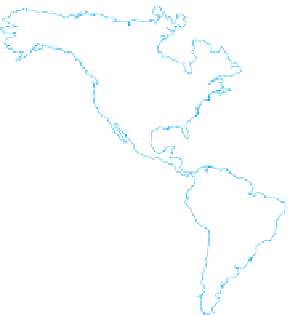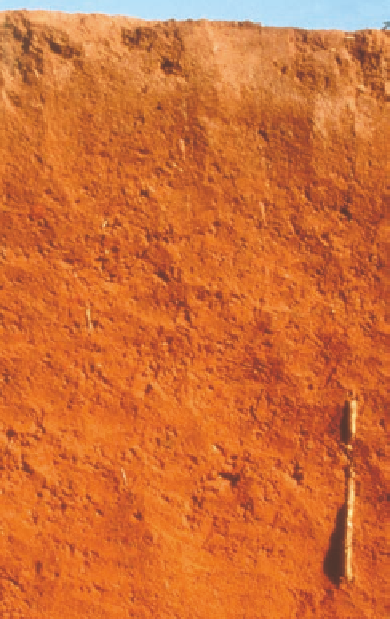Geoscience Reference
In-Depth Information
As with the descriptions of climate and vegetation, the
discussion of soil orders begins by starting at the tropics and
proceeding to higher latitudes. A few soil orders can occur
anywhere under the proper conditions and will be dealt with at
the end of the discussion. While you are studying the various
orders, refer back to Figure 11.22, which shows the geographic
distribution of soil orders and is similar to the global climate
and vegetation maps in Figures 9.2 and 10.6, respectively. You
might want to familiarize yourself with these illustrations again
before you begin your tour of soil orders. Remember that many
different variations of these soil orders arise, given the unique
interactions of the five soil-forming factors; this discussion
provides only a basic overview of their character and distribu-
tion. The discussion of each order is supported by a figure that
includes a map of its global distribution, an example of a typical
landscape associated with the order, and an example of a soil
profile of that order.
Oxisols
Oxisols
are soils that form in tropical environments
and are found in about 8% of the ice-free land area on Earth
(Figure 11.23a). These soils form through a specific soil-forming
process associated with tropical environments called
laterization
,
which means “to become brick-like.” The premise of laterization
is that the hot and wet environment causes a great deal of mineral
weathering to occur within soils. Bases such as calcium, magne-
sium, and potassium ions are rapidly leached because they are eas-
ily mobilized and water consistently percolates through the soil.
Percolating water flow is so steady that even otherwise-resistant
minerals such as silica are leached. The only minerals not leached
are iron and aluminum sesquioxides (minerals containing three
Global distribution of Oxisols
(a)
(c)
Figure 11.23 Oxisols.
(a) Generalized map of Oxisols on Earth.
These soils occur on about 8% of Earth's ice-free area. (
Source:
U.S.
Department of Agriculture.) (b) Oxisol landscape in Hawaii. Note the
reddish color of the soil, which occurs due to extensive weathering
in this tropical environment. These soils are used to grow sugarcane.
(c) A typical Oxisol. Notice the distinctive orange color of this soil, which
occurs because soluble minerals such as calcium and magnesium are
completely leached, leaving iron behind.
(b)
Oxisols
Mineral soils in tropical and subtropical environ-
ments that form through laterization and thus have an oxic
horizon within 2 m of the surface.
Laterization
A regional soil-forming process in tropical and
subtropical environments that results in extensive eluviation of
minerals except for iron and aluminum.











































































































































